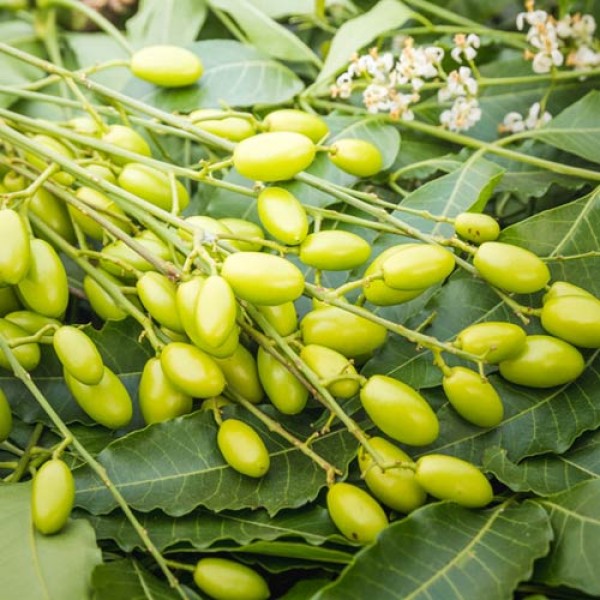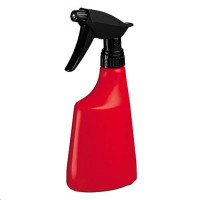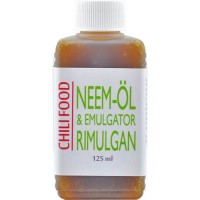
Neem - biodegradable and effective
Neem - biodegradable and effective
When you bring your beloved and well-grown chili plants into your home in autumn, aphids, white flies or fungus gnats often spread explosively after one to two weeks. Here you need a quick and healthy remedy, because you want to eat your chillies later without consuming poisonous insecticides. The products of the Indian Neem tree are a good alternative because they are non-toxic for humans and animals and are even used in cosmetics as skin care products.
What is Neem?
Neem, also known as Niem or Nimba, has been an important remedy in Indian Ayurveda for centuries. The majestic Niem tree (Azadirachta indica) originally comes from the region India / Burma / Pakistan and belongs to the family of mahogany plants. Meanwhile it is planted all over the world in the dry tropics and subtropics. The tree is fast-growing, mostly evergreen and grows 15 to 20 metres high and can get up to 200 years old. If freestanding, mighty crowns form on a short trunk. One uses both the feathered sheets, the bark and the seeds, from which Niem oil is pressed.
It is also known as the "village pharmacy" because of its many uses. In some areas it is considered a lucky charm.
Although the Neem tree has been scientifically studied for decades, many of the more than 100 chemical ingredients have still not been fully researched. In addition, the composition of the ingredients in bark, trunk, leaves and fruits varies considerably. One of the most important ingredients is azadirachtin, as do salannin and meliantrol. The active ingredients nimbin and nimbidin are effective against viruses. Azadirachtin works by resembling a substance that insects need for quinine formation. Therefore, they cannot form an exoskeleton and the formation of pupae and larvae is stopped. The adult animals are not damaged, but the following population dies out and because they have only a short life span, the infestation is soon over.
Neem in Organic farming
You can use Neem in many ways to keep your plants healthy. There are
- neem oil
- neem press cake
- Neem tincture
Neem oil
To extract neem oil, the flesh around the seeds is removed, the seeds are ground and the oil is dissolved from the seeds with hexane. The highest quality neem oil is cold-pressed from the seeds without the use of chemicals. This sometimes has a lighter colour and a milder scent. Neem oil has a viscous consistency and slowly solidifies at temperatures below 21°C. Neem oil has a wound healing and disinfecting effect and can be applied externally to humans and animals. Wounds, inflammations, acne, fungal diseases and even herpes of the lips can be coated thinly with pure neem oil until the wounds have healed completely. When using neem oil for wound, skin or hair care, you should pay particular attention to the quality you buy.
To keep your plants healthy, neem oil is best used in a spray solution with water and an emulsifier that ensures that oil and water mix. Mix one litre of water with 5 ml neem oil and 1 ml rimulgan and pour into a spray bottle. This is effective against aphids, boxwood borers, spider mites, weevils and thrips. You can support the effect by adding further essential oils (tea tree, lavender).
Attention: Neem oil has an irritating effect on the mucous membranes and in case of eye contact it must be rinsed immediately with plenty of water. Neem oil is toxic for cats.
Neem press cake for healthy plants
Neem press cake is formed when the Neem seeds are pressed for oil and is the press residue either in powder form or as granulate. You can use this for fertilizing. By mixing plant soil with neem press cake, the soil is enriched with nitrogen, calcium, phosphorus, magnesium and fertilising salts. The contained azadirachtin inhibits the development of nematodes so that they can no longer damage the roots of the plants. Also sucking insects, such as aphids, spider mites, grass mites and weevils take up the active substance during feeding and can no longer reproduce. Snails also avoid garden beds that have been prepared with Neem.
Dosage:
Flower and vegetable beds, lawns & green areas: rake 100 g per m² easily into the soil. If the soil is already infested 200 g/ m². For salad beds or seedlings, mix 60 g/m² into the substrate. Trees and shrubs: rake approx. 80 g/m² into the soil. You can also mix the neem press cake with compost and spread it on the beds. For a plant soil mixture, add 50 g Neem to 10 litres of plant soil and pot your plants in it.
Neem water: Dosage 30 g Neem press cake on 1 l of water. Pour approx. 60-65°C warm water onto the Neem press cake. It is best to place the mixture in the watering can. Stir vigorously and let the infusion cool for about three hours so that it can be used for watering. Stir again if the press cake has settled on the bottom.
Neem tincture
Neem tincture is an alcoholic extract from Neem leaves, partly also parts of bark and seeds. For a spray agent, mix 1 teaspoon of Neem tincture with 1 litre of water in a spray bottle. Spray the parts of the plant affected by aphids with the solution once a day. If the infestation is very strong also several times daily. If necessary, repeat this procedure every 10 days until all parasites have disappeared.
Neem is ecological and biodegradable
Neem is an ecologically sound product for fertilization and insect repellant with natural active ingredients. The smell of Neem is not unpleasant and can therefore be used for both garden soil and potting soil for indoor plants.
Neem products are eco-friendly. While the pests are strongly impaired in their spread, Neem oil, press cake or tincture are beneficial and bee-friendly. In most cases, further pesticides are no longer needed after the use of Neem.
Manufacturer
Name: | Chili-Food-Wissen |
Address: |










